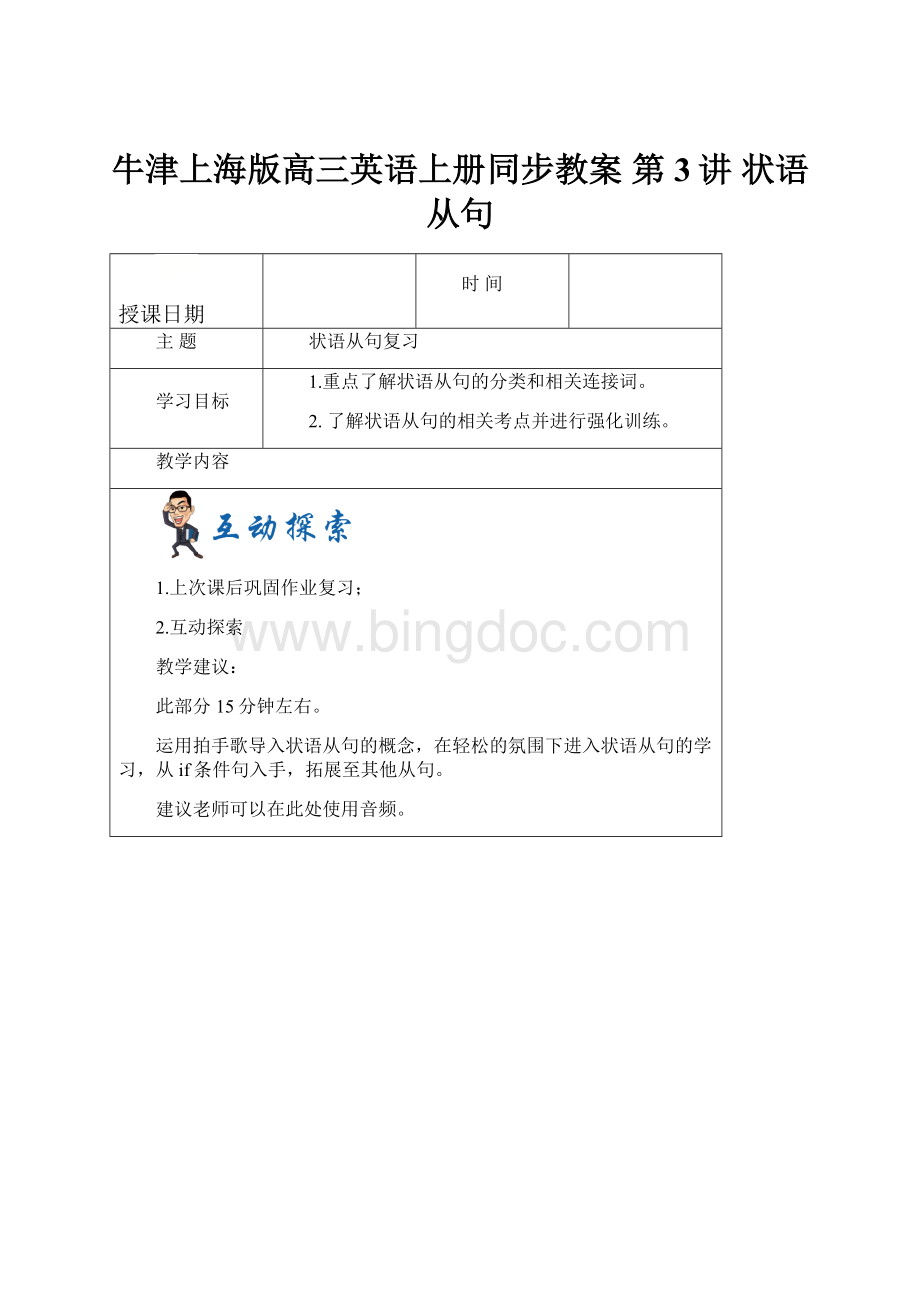牛津上海版高三英语上册同步教案 第3讲 状语从句.docx
《牛津上海版高三英语上册同步教案 第3讲 状语从句.docx》由会员分享,可在线阅读,更多相关《牛津上海版高三英语上册同步教案 第3讲 状语从句.docx(31页珍藏版)》请在冰点文库上搜索。

牛津上海版高三英语上册同步教案第3讲状语从句
授课日期
时间
主题
状语从句复习
学习目标
1.重点了解状语从句的分类和相关连接词。
2.了解状语从句的相关考点并进行强化训练。
教学内容
1.上次课后巩固作业复习;
2.互动探索
教学建议:
此部分15分钟左右。
运用拍手歌导入状语从句的概念,在轻松的氛围下进入状语从句的学习,从if条件句入手,拓展至其他从句。
建议老师可以在此处使用音频。
Ifyouarehappy
Ifyou’rehappyandyouknowitClapyourhands
IfyouarehappyandyouknowitClapyourhands
Ifyou’rehappyandyouknowit
Neverbeafraidtoshowit
Ifyou’rehappyandyouknowitClapyourhands
Ifyou’rehappyandyouknowitStompyourfeet
Ifyou’rehappyandyouknowitStompyourfeet
Ifyou’rehappyandyouknowit
Neverbeafraidtoshowit
Ifyou’rehappyandyouknowitStompyourfeet
Ifyou’rehappyandyouknowitWinkyoureye
Ifyou’rehappyandyouknowitWinkyoureye
Ifyou’rehappyandyouknowit
Neverbeafraidtoshowit
Ifyou’rehappyandyouknowitWinkyoureye
教学建议:
此部分60分钟左右;是本节课的重点。
请做到讲练结合,尽量做到每一个知识点都附有相应的练习题;最多不超过3个知识点必须附有相关知识点练习
【知识梳理1】时间状语从句
一、概念及引导词:
引导时间状语从句的连词有很多,常见的有before,after,when,while,as,since,till,until,assoonas等。
二、时间状语从句高考重难点突破
1.when,while和as的区别
Whenshecamein,Istoppedeating.她进来时,我停止吃饭。
(瞬间动词)
WhenIlivedinthecountryside,Iusedtocarrysomewaterforhim.
当我住在农村时,我常常为他担水。
(延续性的动词)
Wewereabouttoleavewhenhecamein.我们就要离开,就在那时他进来了。
(瞬间动词)
Whilemywifewasreadingthenewspaper,IwaswatchingTV.(wasreading是延续性的动词,wasreading和waswatching同时发生)
Ilikeplayingfootballwhileyoulikeplayingbasketball.我喜欢踢足球,而你喜欢打篮球。
(对比)
Wealwayssingaswewalk.我们总是边走边唱。
(as表示“一边……一边”)
Aswewasgoingout,itbegantosnow.当我们出门时,开始下雪了。
(as强调句中两个动作紧接着先后发生,而不强调开始下雪的特定时间)
2.after和before的区别
before引导的从句不再用否定式的谓语,并且当before引导的从句位于主句之后,有时译成“就,才”。
还要注意主句和从句之间的时间关系。
当主句用将来时,从句总是用现在时;如果before引导的从句谓语用的是过去时,则主句动词多用过去完成时,这样以便体现动作发生的先后。
After表示主句动作发生在从句动作之后。
主句和从句的动作的时间关系正好与before引导的从句相反。
Itwillbefourdaysbeforetheycomeback.他们要过四天才能回来。
Einsteinalmostknockedmedownbeforehesawme.爱因斯坦几乎把我撞倒才看到我。
MyfatherhadleftforCanadajustbeforetheletterarrived.我父亲恰好在信到之前去加拿大了。
Theyhadnotbeenmarriedfourmonthsbeforetheyweredivorced.他们结婚还不到四个月就离婚了。
Afteryouthinkitover,pleaseletmeknowwhatyoudecide.你仔细考虑过以后,告诉我你是怎样决定的。
Afterwehadfinishedthework,wewenthome.完成工作之后,我们回家了。
(从句用过去完成时,主句用一般过去时)
3.since的用法
since引导的从句的谓语动词可以是延续性的动词,又可以是瞬时动词。
一般情况下,从句谓语动词用一般过去时,而主句的谓语动词用现在完成时。
但在Itis+时间+since从句的句型中,主句多用一般现在时。
IhavebeeninBeijingsinceyouleft.自从你离开以来,我一直在北京了。
WherehaveyoubeensinceIlastsawyou?
自上次我和你见面以后,你到哪里去了?
ItisfouryearssincemysisterlivedinBeijing.我妹妹不在北京住有四年了。
ItisfivemonthssinceourbosswasinBeijing.我们老板离开北京有五个月了。
句型区别:
1.Itissince从…以来多长时间了(因为since+从句或名词,表示一段时间)
Itisfiveyearssincewemetlasttime.从我们上次见面已经五年了。
2.Itis+before…(…才)
ItwasalongtimebeforeIwenttosleepagain.过了很长时间我才睡着。
Itwasanhourbefore(=until)thepolicearrived.过了一个小时,警察才来
3.nosooner...than和hardly...when的用法
hardly(scarcely,rarely)…when/before,nosooner…than相当于assoonas之意。
主句用过去完成时,从句用一般过去时。
当hardly,scarcely,rarely和nosooner位于句首时,主句应用倒装语序。
Hehadnosoonerarrivedhomethanhewasaskedtostartonanotherjourney.
他刚到家,就被邀请开始另一旅程。
Nosoonerhadthesunshownitselfabovethehorizonthanhegotoutofbedtocommencework.
太阳刚从地平线上升起,他就起床劳动去了。
HardlyhadIsatdownwhenhesteppedin.我刚坐下,他就进来了。
Hehadhardlyfallenasleepwhenhefeltasofttouchonhisshoulder.
他刚要入睡就感到肩膀上被轻轻一触。
【例题精讲】
1.Agoodstorytellermustbeabletoholdhislisteners’curiosityhereachedtheendofthestory.
A.whenB.unlessC.afterD.until
2.Hetransplantedthelittletreetothegardenitwasthebesttimeforit.
A.whereB.whenC.thatD.until
3.Hewasabouttotellmethesecretsomeonepattedhimontheshoulder.
A.asB.untilC.whileD.when
Keys:
DBD
【巩固练习】
1.youunderstandthisrule,you’llhavenofurtherdifficulty.
A.WhileB.OnceC.ThoughD.Unless
2.Substanceswillexpandorcontractheatedorcooled,butthisisnotthecasewithwater.
A.whentheywillbeB.iftheywillbeC.astheybeingD.when
3.Itwillnotbelongmancanharnessthesolarenergyandmakeitservemankind.
A.sinceB.beforeC.whenD.after
4Itwasfoundthatalthoughthegirlcouldperceivethingswithherfingers,thisabilityceasedherhandswerewet.
A.themomentwhenB.themomentC.inthatmomentD.before
5.Amanescapedfromtheprisonlastnight.Itwasalongtimetheguardsdiscoveredwhathadhappened.
A.beforeB.untilC.sinceD.when
6.Wehadn’tmetfor20years,butIrecognizedherIsawher.
A.themomentB.themomentwhen
C.forthemomentD.atthemomentwhen
7.heenteredtheuniversity,hisEnglishhasbeenmuchimproved.
A.BeforeB.AfterC.WhenD.Since
8.HehasbeentoBeijingforseveraltimeshecametoChina.
A.beforeB.whenC.sinceD.as
9.Iwatchedhimhedisappearedfromsightinthedistance.
A.unlessB.untilC.asD.when
10.Itwasgoingtobesometimehewouldseehisparentagain.
A.sinceB.untilC.whenD.before
11Manyyoungpeopleroseandshoutedthepopsingerappearedonthestage.
A.atthemomentB.onseeingC.themomentD.whentheysaw
12.hemadeuphismindtodosomething,nothingcanchangehismind.
A.OnceB.UnlessC.AlthoughD.Assoonas
Keys:
1-6.BDBBAA7-12.DCBDCA
【知识梳理2】原因状语从句
一、概念:
用表示原因的连词连接一个句子作状语,这样的主从复合句就是原因状语从句。
二、引导词:
主要的有because,as,since,for,seeing(that),now(that),considering(that),inthat等。
三、原因状语从句的连接词
1:
because
引导的原因状语从句一般放于主句之后,because表示直接原因,语气最强,最适合回答why引导的疑问句。
例如:
IdoitbecauseIlikeit.我做这件事是因为我喜欢。
注意:
“not...because”结构中的not否定的是because引导的整个从句,例如:
Thecountryisnotstrongbecauseitislarge.国强不在大。
2:
since
引导的原因状语从句一般放于主句之前表示已知的、显然的理由(通常被翻译成“既然”),较为正式,
语气比because弱。
例如:
Sinceyouarefreetoday,youhadbetterhelpmewithmymathematics.
既然今天你休息,你最好帮我补习数学。
注意:
seeing(that),now(that),considering(that),inthat这几个词汇与since引导的原因状语从句意思相近,都表示“既然”。
例如:
Seeing(that)herefusedtohelpus,there’snoreasonthatweshouldnowhelphim.
Now(that)youaregrownup,youshouldnotrelyonyourparents.
Considering(that)everybodyishere,let’sbeginourdiscussion.
Inthatheisill,hefeelsunabletodoit.
3:
as
引导原因状语从句时表示附带说明的“双方已知的原因”,语气比since弱,较为正式,位置较为灵活(常放于主句之前)。
例如:
Asitisraining,you’dbettertakeataxi.既然在下雨,你最好乘出租汽车。
Asyouaretired,youhadbetterrest.既然累了,你最好休息一下。
Iwenttobedearly,asIwasexhausted.我睡得早,因为我筋疲力尽了。
4:
for
引导的是并列句表示原因但并不说明主句行为发生的直接原因,只提供一些辅助性的补充说明,for引导的并列句只能放于主句之后并且必须用逗号将其与主句隔开。
例如:
Hecouldnothaveseenme,forIwasnotthere.他不可能见过我,因为我不在那里。
关于not…because结构
该结构中的否定词有时否定主句,有时否定从句,一般要根据句子的意思做出正确或合乎逻辑的理解。
若not否定主句,最好在because之前用逗号,否则会引起歧义,如下句在没有特定上下文时就有两种解释:
Ididn’tgobecauseIwasafraid.我没有去是因为怕。
/我不是因为怕才去。
不过若because之前有just修饰,一般认为not是否定从句的:
Youshouldn’tgetangryjustbecausesomepeoplespeakillofyou.你不要因为有人说你坏话而生气。
比较:
because,since,as和for
1) because语势最强,表示不知道的原因用because,即说话人认为听话人不知道。
因此because从句是全句最重要的部分,通常被放置于主语之后。
当原因是显而易见的或已为人们所知,就用as或since。
Ididn’tgo,becauseIwasafraid.
Since/Astheweatherissobad,wehavetodelayourjourney.
2) for虽然表示不知道的原因,但因语气比because弱得多,是可说可不说的话,只能位于主语之后,这时,for是并列连词,如果不是因果关系,而是对前面主语内容加以解释或推断时,只能用for。
Heisabsenttoday,because/forheisill.
Hemustbeill,forheisabsenttoday.
【例题精讲】
1.Parentsshouldtakeseriouslytheirchildren’srequestforsunglasseseyeprotectionisnecessaryinsunnyweather.
A.becauseB.thoughC.unlessD.if
2.theweatherwasfine,Iopenedallthewindows.
A.AsB.BecauseofC.ForD.With
3.youwouldn’tliketogothere,youmightaswellstayhere.
A.EvenifB.EvenC.NowthatD.Although
4.timewenton,whatourteachersaidprovedtrue.
A.AsB.SinceC.WithD.Because
5.Hemarriedherhelovedherbutbecausehewasindebtedtoher.
A.becausenotB.notbecauseC.becauseD.though
Keys:
1-5AACAB
【知识梳理3】条件状语从句
一、概念:
状语从句在复合句中起状语的作用,用于修饰主句中的谓语动词、形容词和副词等。
状语从句一般由连词引导,连词不充当任何成分,只起连接作用。
在句子中起宾语作用的从句叫做宾语从句。
二、引导词:
引导条件状语从句的从属连词主要有if,unless,as/solongas等。
例句:
Don’tcomeunlessItelephone.除非我打电话,否则你别来。
Ifyouwatchcarefullyyouwillseehowtodoit.如果你仔细看,你会看出该怎样做。
Aslongasyoudoyourbest,we’llbehappy.只要你尽力,我们就满意了。
1.条件状语从句常见的引导词:
1)incase表示“如果”、“万一”
IncaseIforget,pleaseremindmeaboutit.
如果我忘了,请提醒我。
Takeacoatincasetheweatherturnscold.
带上一件外衣吧,以防天气转凉了。
Takeataxiincaseyouarelateforthemeeting.
作车租车去,免得开会迟到。
注意:
incase的意思是“万一,以防”,常用来引导条件状语从句。
扩展:
2)if和unless表示“如果,除非……;如果不……”的意思,相当于if…not…,有时二者可以换用。
Ifyouhaveanyquestionsorcomments,youcanvoicethemnow.
你们如果有任何疑问或意见,可以现在提出。
Ifyoudon’tvisithimtomorrow,hewillbeangry.
如果你明天不去看他,他会生气的。
=Unlessyouvisithimtomorrow,he’llbeangry.
除非你明天去看他,否则他就会生气的。
3)aslongas和solongas表示“只要”的意思
Naturally,solongastheycanunderstand.当然可以,只要他们能理解。
SolongasIlive,Imuststudy.只要还活着,我就要学习。
Verywell,solongaseverybodyjoinsin.很好,只要大家都参加。
Solongasstudiesattentively,anythingwilllearnwell.只要用心学,什么都可以学好的。
4)Provided/supposing/onconditionthat表示“在……的条件下”
Wecanfinishthejobintimeprovided/onconditionthatthereisastablesupplyofmaterial.
在材料供应稳定的前提下,我们能够按时完成任务。
注意:
providedthat表示“在……的前提/条件下”,就是onconditionthat,其格式固定,不用providingthat。
Supposingthatnowyouareattheairport,thenyoucandirectlytakethebluebustogettothehotel.
如果你现在到了机场,你可以直接乘坐巴士到酒店。
注意:
supposingthat也表示“在……的前提/条件下”.假设你已经到达了机场的条件下,你就可以选择巴士公共交通去酒店了。
5)once表示“一旦……就……”
OnceIkilledyou,youarenotabletoliveon.
一旦我杀了你,你就不能存活了。
注意:
once引导条件状语从句,表示“一旦”。
Once可以用作时间状语从句,也可以翻译成为一……就……,只是哪个更贴切的不同。
3.条件状语从句的时态
遵循原则:
主句与从句时态上保持一致的原则。
1)He’llbeadoctorwhenhefinishesstudyinghere.
他结束在这儿的学习之后,将会成为一名医生。
Ifitdoesn’traintomorrow,we’llstart.
明天如果不下雨,我们